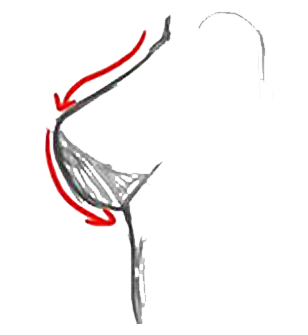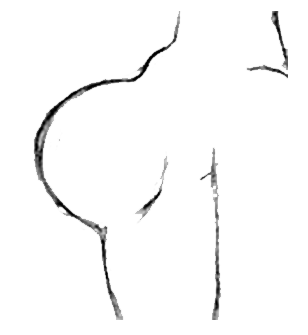Breast lift is achieved through a variety of incisions in order to remove the skin. However, if we only remove the skin, then the risk of future sagging is significant whereas if we also reconstruct your breast tissue as well, then it’s much more likely your breast lift results will last longer. At the HAPSI we use the most modern and efficient breast tissue anchoring techniques in order to maximize the longevity of your breast lift results. We have a wide range of experience with a number of techniques and we customize the procedure based on your unique anatomy and preferences.
Breast Lifts can be performed, depending on the severity of your ptosis, through an incision:
- around the areola only (periareolar or donut or Benelli technique)
- around the areola and a short vertical incision (vertical or lollipop technique)
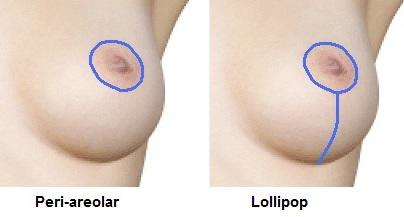
As mentioned earlier, in both techniques, the areola is repositioned at a higher position but it is not removed completely and sutured back on as many people believe. The appropriate technique for you is determined based on your current breast size and shape, the desired breast size, the size and position of your areolas, the degree of breast sagging and the amount, quality and elasticity of your skin.
Below please find a more detailed analysis of the breast lift techniques:
PERIAREOLAR BREAST LIFT TECHNIQUE
(WITH OR WITHOUT BREAST IMPLANTS)
This technique is also called a Benelli or donut mastopexy. For women with mild droopiness (ptosis) needing a minor breast lift, this circumareolar (circular) breast lift is a great choice. This technique is most commonly performed in conjunction with breast implants, however it can also be performed as an isolated procedure on a small group of women with minor breast ptosis and good breast volume.
The circumareolar breast lift is performed by initially making a circular incision (which also will mark the new smaller size of the areola). Next, another, larger circular incision is created at a distance from the first incision. Finally the circular pattern of skin is removed in between these two circular incisions. The skin is then tightened around the areolas like a “purse string”, the breasts are lifted and the areolas are repositioned in a higher location. The areola is not removed and sutured back. Additional sutures are then placed to precisely close the circle incision.
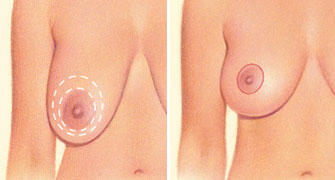
In most cases women needing a small lift also desire additional breast fullness so a combined circumareolar breast lift and breast augmentation is the best approach. The breast implant in this situation is placed through the bottom edge of the circular incision. The implant may be round or tear-drop and is placed in the above-muscle or below-muscle position depending on the individual needs of the breast (amount of breast tissue in the upper pole, amount of fat, skin quality etc.) This is an approach used frequently as it provides excellent cosmetic results through a small circular nipple incision. However it does not provide a very significant uplift and it works ideally only in small degrees of ptosis but not for moderate or severe ptosis of the breasts.
VERTICAL OR LOLLIPOP BREAST LIFT TECHNIQUE
(WITH OR WITHOUT BREAST IMPLANTS)
The vertical breast lift (mastopexy) technique is for women with moderate to severe degrees of breast ptosis. This is the most frequently performed breast lift technique. With this technique a vertical key-hole incision is made and the skin inside the key-hole which is created is removed. Once the keyhole skin is closed, the final incision is a lollipop-shaped incision.
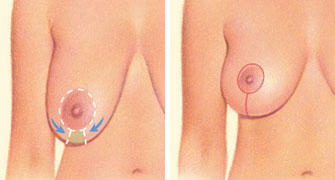
Most women undergoing this type of breast lift also desire additional breast fullness so a combined vertical lift with breast augmentation is usually performed. The breast implant in this situation is placed through the bottom edge of the vertical incision. The implant may be round or tear-drop and is placed in the above-muscle or below-muscle position depending on the individual needs of the breast (amount of breast tissue in the upper pole, amount of fat, skin quality etc.)

Step 1: Appropriate “keyhole” design on skin. This must be marked before surgery with great precision.

Step 2: Excision of superficial skin layer and access to the deeper tissues. If an implant is required, it is placed through the lower end of this opening.

Step 3: Tightening of the internal breast tissues in order to adequately lift the breast and achieve a long-term breast lift result. There are several types of tissue anchoring techniques depending on the individual’s breast anatomy. At the HAPSI, we select to utilize the techniques that combine safety and ideal breast reshaping.

Step 4: Closure of skin with special layered techniques in order to minimize scarring. The areola is sutured into a higher position and the skin is closed around the areola and down close to the crease of the breast. The final scar is like a lollipop, with a scar around the areola and straight down the center of the breast. On occasion, a small horizontal scar is placed in the under-breast fold to help smooth out the closure. Absorbable sutures are used for closure.



